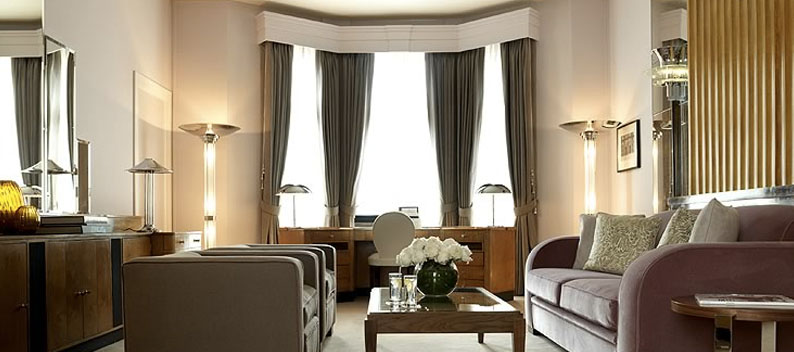Part Seven: The Birth of Modernism
In the 20th century, the two world wars brought a shortage of materials including fabrics and metals, but also a rapid speed of technological development in every area of design and architecture. Larger homes were being converted into flats, new housing subdivisions and towns exploded and more efficient high-rises began to appear along with small cottages and bungalows. Most of these had smaller windows which required much less fabric and thus simpler curtaining.
Modernist movements in Europe, such as Le Corbusier’s technology-inspired Five Points of Architecture marked a turning point in the 30s, pushing the idea that new constructions had made traditional draperies unnecessary, and in fact ‘effeminate’.
While the ‘transparent’ trend did not sit well with most home occupants, who still craved a sense of privacy, the need to worry about drafts was reduced as radiators were incorporated into new constructions and the development of synthetic materials and built in curtains meant larger rooms could be partitioned into more manageable spaces to keep out noise and light. Thus while the strictly decorative element of curtains receded, their practicality did not.
Straight draperies – Art deco curtains
The Art Deco movement was the first streamlined, modern look, with its motifs of speed and light, trains, cars and travel also emphasizing efficient use of space. Clutter and items of decorative nature only gave way to spare lines, smaller furniture and overall convenience. While black and white was extremely popular, other colour schemes such as blue and gold or bright metallics made strong contemporary statements. This built-for-speed look was equally evident in straight-hung paired curtains under a simple box pelmet, or drapes tied back high for a look both slender and flowing.
Egyptian inspiration followed the discovery of Tutankhamen’s tomb in the 20s, and rectangular forms such as concentric half-circles, chevrons or pyramids with rounded corners took over from fussy florals.
In the 1940s, a shortage of decorative hardware led to straight draperies without any tie backs, and under-curtains became shorter and sheerer with the invention of synthetics like rayon, acetate and nylon. These fabrics were not only inexpensive, but resistant to shrinking and creasing, easy to wash thus also considered more hygienic. Pelmet boxes were usually white or wood stained.
Quest for Light – modern curtain fabrics
Colours were also much more sedate as modernism became the norm. High contrasts gave way to neutral schemes in beige, dusty pink and coral or coppery greens and blues. By the 1950s, the light, bright influence of Danish modern was felt and Scandinavian motifs began to appear. This was also the era of the large plate glass window covered by a built in curtain wall with casement fabrics. As it was usually only closed at night, the need for traditional under sheers was reduced.
From the 60s until today, the quest for airy, efficient but still elegant window dressing remains. Natural light has become increasingly sought after, and as window sizes have grown, curtains have remained a necessity, but are now almost always built in and their workings much simplified. Semi-sheer, light-diffusing casement fabrics with easy-care outer curtains may change their colours and patterns by the decade, the psychedelic 60s giving way to the orange, brown and nubby 70s, the austere 80s and the Laura Ashley style country house casual, but all are far away from the days when servants were needed to pull heavy draperies or wash them.




